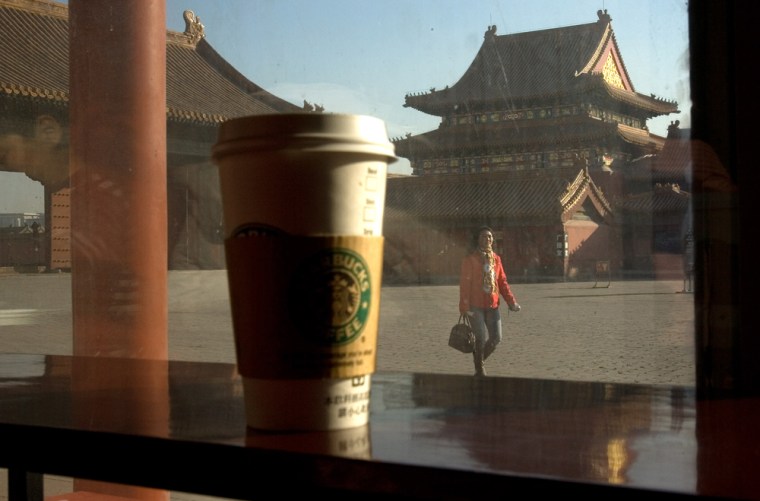Beijing's Forbidden City palace is considering closing a Starbucks on its grounds after protests led by a state TV personality who says the American coffeehouse's presence is eroding Chinese culture, a news report said Thursday.
"The museum is working with Starbucks to find a solution by this June in response to the protests," the official Xinhua News Agency quoted a palace spokesman, Feng Nai'en, as saying.
A news anchor for China Central Television has led an online campaign to remove the Starbucks, which opened in 2000 at the invitation of palace managers, who needed to raise money to maintain the 587-year-old complex of villas and gardens.
Starbucks' presence "undermined the Forbidden City's solemnity and trampled over Chinese culture," the anchorman, Rui Chenggang, wrote in his blog. Xinhua said "thousands of Chinese" backed the campaign but did not say how.
Starbucks' fate will be decided as part of a renovation that already has seen one-third of the shops removed from the vermillion-walled, 178-acre palace, Feng said.
"Whether or not Starbucks remains depends on the entire design plan that will be released in the first half of the year," he said.
Starbucks' vice president for Greater China, Eden Woon, declined to say whether the two sides were discussing closing the outlet.
But the company issued a statement defending its operation.
"Starbucks appreciates the deep history and culture of the Forbidden City and has operated in a respectful manner that fits within the environment," the statement said. "We have provided a welcome place of rest for thousands of tourists, both Chinese and foreign, for more than six years."
The palace Starbucks has been the target of similar criticism in the past. Shortly after it opened, the company agreed to remove an outdoor sign following complaints that it was inappropriate.
The palace is among 24 Chinese sites granted World Heritage status by the U.N. Educational, Scientific and Cultural Organization.
The communists have been accused of failing to maintain China's vast inheritance of palaces, temples and other cultural sites and of seeking such UNESCO designations to promote tourism.
Rui, the driving force behind the Starbucks protest, is a telegenic 29-year-old Communist Party member and fluent speaker of English who works for CCTV's English-language channel.
The controversy is unusual for Rui, a rising media star who spent the 2005-06 school year as a visiting fellow at Yale University. His blog says that at Yale, he gave talks to undergraduates "introducing to them the truth about the fatherland."
Other entries on his blog describe a drive in California and his meetings with former U.S. Secretary of State Henry Kissinger and other famous people.
The controversy was reported Thursday on CCTV's national midday news, though it failed to mention that the protests were initiated by one of the broadcaster's employees.
The report quoted an unidentified Chinese visitor as saying tourists found it odd that Starbucks was in the palace.
Seattle-based Starbucks Corp. opened its first China outlet in 1999 and has grown to 220 coffeehouses. Chairman Howard Schultz described China last year as the company's No. 1 growth market.
Last February, Starbucks gave $1.5 million to a Chinese teacher-training program and said it planned to make an additional $3.5 million in charitable donations in China.
The Forbidden City was home to 24 emperors before the end of imperial rule in 1911. It is China's top tourist attraction, drawing some 7 million visitors a year.
Other businesses on its grounds include bookstores, souvenir shops and Chinese-style teahouses.
The renovation, due to last through 2020, is meant to restore the palace to its imperial-era appearance and calls for tearing down a five-story museum and other modern buildings.
